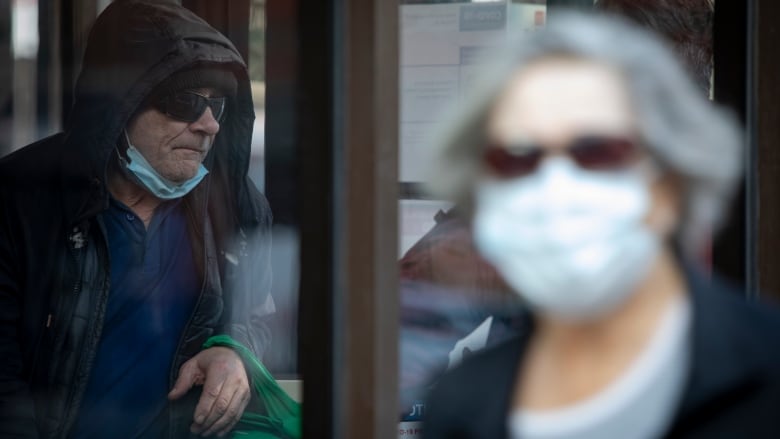Here's what you need to know as Ontario lifts its mask mandate
'If we start to see all masks droplike a T-shirt on a beach...it's probably not a good thing,' expert says

Starting Monday, it will largely be up to you whether or not to wear a mask to protect yourself and others against COVID-19 in Ontario.
The province is lifting its maskmandate for most indoor settings, even as experts warnof an increase in infectionsandhospitalizations in the coming weeks as a result.
That increase should be manageable, the experts say, but how the public responds to the change will matter. And with the province moving to lift allremaining public health measures by the end of April, individuals will have even more of a hand in what the future of COVID-19 in Ontario looks like.
Health experts and officialsgenerally agreethat individuals should weigh their own risk when deciding whether to wear a mask to curb their own chances of infection and the spread of the virus.
To help you make up your mind, here's a look back at this week's COVID-19 data and some highlights out of the science advisory table's latest guidance.
Hospitalizations likely to rise, modelling suggests
Overall case counts no longer paint a clear picture of where the province stands when it comes to infection rates because of restricted access to PCR testing.
Butnew modelling released Thursday by Ontario's science advisory table suggestsbased on a slightuptickin wastewater datawe could soon see a rise in hospitalizations and ICU occupancy.
On Monday, Ontario reported 602 people hospitalized with the virus and 228 patients in intensive care.
Hospitalizations jumped to 688 the next day. Meanwhile, the number of people in ICU continued its gradualdecline, with 220 reported Tuesday. Not all hospitals report data over the weekend, however.
Hospitalizations continued to decline daily after that, hitting 615on Friday. ICU occupancy also dipped below 200 on Thursday for the first time this year something not seen since Dec. 21, 2021.
As for infections, Ontario saw arolling seven-day average of 1,768 this week based on very limited testing. The province reported 1,116 confirmed cases on Monday and 1,076 on Tuesday, but that figure rose past the 2,000-mark to 2,011 on Wednesdayand 2,398 on Thursday.
The actual number of new daily infections is likely between 15,000 and 20,000, according to the science advisory table, with 3.5 million to four million peopleinfected since Dec. 1.
Meanwhile, the test positivity rate ranged from 12 to 13 per cent based on the PCR testing conducted.
The daily number of deaths reported is also decreasing with another 59deaths reported this past week.
BA.2 subvariant likely to become dominant this month
A moderate increase in COVID-19 spread will likely mean morehospitalizations, but not more than 1,000, the science advisory table projects.
So what could lead to that kind of increase?
According to the advisory table, a moderate increase in transmission could happenif people increase their contacts by 40 per cent and half of those contacts are not wearing masks. It could also happenif people increase their contacts by 30 per cent and half are maskless, but the more transmissible Omicron subvariant BA.2 becomes dominant.

With BA.2 expected to become the dominant strain in Ontario this month, the advisory table has said the government should be prepared to reintroduce mask mandates, reintroduce vaccine certificates and require a third dose if necessary, as well continue to improve ventilation and air filtration in public spaces.
What's next
Starting Monday, the province will stop enforcing masking rules in most indoor settings including schools,restaurants, gyms and stores. Individuals and business ownerswill be able to choose whether or not they will still require masking.
Meanwhile, weekly scheduled briefings held by Chief Medical Officer of Health Dr. Kieran Moore came to an end last week, with the top doctor announcing he will hold updates on the pandemic situation in Ontario when needed.
Mandates will still remain in place for a period of time for public transit, long-term care and retirement homes, shelters, jails and congregate care and living settings.
Heading into the fall, as immunity wanes from vaccines orfrom prior infection,the advisory table sayswe may again begin to see some of the surges that we've experienced over the past two years.
For now though, each person should make a personal risk assessment when it comes to wearing masks as the province learnsto "live with and manage COVID-19," Moore has said.
Moore himself says hewill continue to wear a mask in places like department stores based on his own risk assessment and encourages people to continue wearing masks in high-risk settings.
With warmer weather ahead, Dr. Peter Jni, head of the science advisory table, says if "we take it slow" and ifmore people get their recommended full vaccine series,the situation in the province should look "relatively OK."
But he cautions people must be cautious in busy indoor environments.
"If we start to see all masks droplike a T-shirt on a beach then it's probably not a good thing."












_(720p).jpg)


 OFFICIAL HD MUSIC VIDEO.jpg)
.jpg)



























































































